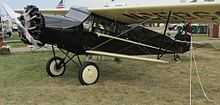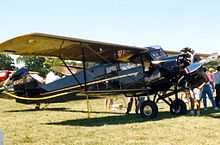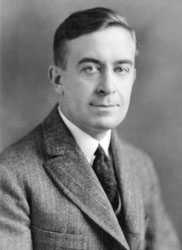Buhl Airsedan
| CA-6 Airsedan | |
|---|---|
 | |
| CA-6 Airsedan "Spokane Sun-God", Felts Field 1929 | |
| Role | Civil utility aircraft |
| Manufacturer | Buhl Aircraft Company |
| Designer | Etienne Dormoy |
| First flight | 1928 |
| Number built | ca. 60 |
|
| |
The Buhl AirSedan was a civil utility aircraft manufactured in the United States that holds the first transcontinental non-stop roundtrip flight record in 1929 with the Buhl AirSedan "Spokane Sun-God".
Development
The Buhl Airsedan was a civil utility aircraft manufactured in the United States by Buhl Aircraft Company in the late 1920s and early 30s. Later models featured gradually increased seating and larger engines, but all were conventional sesquiplanes with fully enclosed cockpits and passenger cabins.
After Buhl ceased operations, the drawings and jigs were purchased and a small number of CA-6's were built in Canada by the Ontario Provincial Air Service (OPAS) for use as fire spotting aircraft. These differed from the original plans in having more powerful 440 HP Pratt & Whitney engines and Vickers floats.
The prototype CA-3 Airsedan was flown in the 1928 National Air Races, and was purchased in the 1960s by Ed Marquart for restoration. The aircraft was modified for a Lycoming radial engine installation and sold to the Buhl family after his death in 2007. The aircraft was restored to flying condition by Andy Bowman in 2012.[1]
Operational history
One Airsedan, Angelino Jr was piloted by Loren Mendell to first place in the 1929 Oakland-Cleveland Air Derby, and another, Spokane Sun God was used to make the first nonstop roundtrip flight across the United States. Nick Mamer and Art Walker flew it from Spokane, Washington to New York City and back between 15 and 21 August 1929, taking 120 hours 1 minute 40 seconds for the trip and using inflight refuelling to make the distance.
Variants

- CA-3 Airsedan - original three-seat version powered by Wright J-5
- CA-3A
- CA-3B Junior Airsedan - slightly smaller version with Warner Scarab engine
- CA-3C Sport Airsedan
- CA-3CW Sport Airsedan - Pratt & Whitney Wasp engine
- CA-3D Sport Airsedan - Wright J-6 engine

- CA-3E Sport Airsedan - Packard DR-980 engine
- CA-5 Airsedan - five-seat version powered by Wright J-5
- CA-5A Airsedan - Deluxe version
- CA-6 Airsedan - six-seat version powered by Wright J-6
- CA-6A Airsedan - 420 hp Pratt & Whitney Wasp engine
- CA-6B Airsedan - 450 hp Pratt & Whitney Wasp engine
- CA-6D Special - six-seat conversion of CA-3D (2 converted)
- CA-6J Airsedan - five seats and 300 hp Pratt & Whitney Wasp (1 converted from CA-6)
- CA-6W Airsedan - four seats and 420 hp Pratt & whitney Wasp (1 converted from CA-6)
- CA-8 Senior Airsedan - eight-seat version powered by 450 hp Pratt & Whitney Wasp
- CA-8A Senior Airsedan - Wright Cyclone engine
- CA-8B Senior Airsedan - 520 hp Pratt & Whitney Wasp
Aircraft on display
- Golden Wings Museum, Blaine, Minnesota
- Canadian Bushplane Heritage Centre, Sault Ste. Marie, Ontario - some parts from the unrestored remains of two OPAS Buhls (C-FOAR and C-FOAT)
Specifications (CA-6)
General characteristics
- Crew: one pilot
- Capacity: 5 passengers
- Length: 29 ft 8 in (9.04 m)
- Wingspan: 40 ft 0 in (12.20 m)
- Powerplant: 1 × Wright J-6 radial, 300 hp (224 kW)
Performance
- Maximum speed: 145 mph (233 km/h)
- Range: 720 miles (1,160 km)
See also
References
| Wikimedia Commons has media related to Buhl Airsedan. |
- ↑ "A Rare chance to see a Rare Buhl". Retrieved 17 August 2012.
- Taylor, Michael J. H. (1989). Jane's Encyclopedia of Aviation. London: Studio Editions. p. 216.
- aerofiles.com
- The Flight of the Buhl Airsedan Spokane Sun-God first airplane to make a non-stop transcontinental round-trip flight
| |||||||||||||||||||||||||
| ||||||||||||||||||||||
